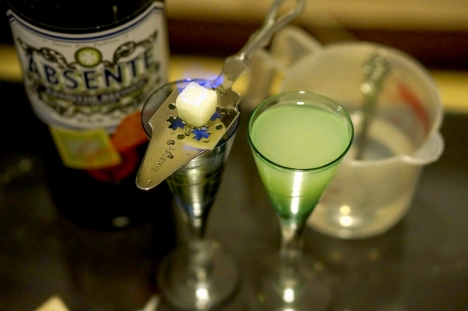It's the drink that, more than any lover, drove a generation of artists, from Van Gogh to Oscar Wilde and Verlaine, to distraction.
Absinthe was their muse, their creative rocket fuel, but the fabled "fee verte" (green fairy), which they venerated in painting and prose, was also their ruin. That was the theory, at least, when France banned the green-tinted liquor during World War 1, claiming it drove drinkers insane.
A century later, absinthe's reputation has been rehabilitated, and drinkers are once again coming under its seductive spell.ugar
"We are progressing slowly, but we are progressing," says Francois Guy, an absinthe distiller whose output has increased exponentially over the past decade, shooting up from 7,200 litres (7,600 quarts) in 2001 to 30,000 litres (31,700 quarts) last year.
Since France lifted the ban on selling and drinking absinthe in 1988, Guy has been hard at work to help the spirit shed its dark — and, as it turns out, inaccurate — image.
But the misconceptions about the legendary beverage, which still inspire suspicion and fear in many drinkers, are tenacious.

(An absinthe store in Paris. Photo: Adrian Skottow/Flickr)
'The forbidden drink'
"Absinthe remains the forbidden drink that drives people crazy — there will always be that mysterious aura around it," said Fabrice Herard, organiser of the Absinthiades events that showcase the liquor in Pontarlier, its historical French home near border with Switzerland.
Switzerland is where the drink, which is made from artemisia absinthium, commonly known as wormwood, and anise, originated in the 18th century.
But it was in late 19th century Belle Epoque Paris that absinthe had its heyday, becoming the favourite refreshment of Vincent Van Gogh and Henri de Toulouse-Lautrec and a string of scribes, including poets Charles Baudelaire and Paul Verlaine.
But the ravaging mental effects it had on many addicted drinkers — described in detail in French writer Emile Zola's "L'Assommoir" — led France to prohibit the alcohol in 1915.
Authorities explained the prohibition with evidence linking the thujone chemical in absinthe to the insanity suffered by many of its consumers, who gained notoriety for being the most hopeless and unruly of alcoholics.
In pinning the mind-blowing effects of absinthe on thujone, however, they breezily discounted the potency of its 45 -72 alcohol degree content.
"Absinthe drove people crazy because they drank too much of it, at too high alcohol strengths," Guy, whose eponymous family distillery was found in Pontarlier by his grandfather in 1890, said.
The banning of the spirit in France and several other countries caused economic calamity in Pontarlier.
In the 1900s, Pontarlier had 23 distilleries, which produced 10 million litres of absinthe for domestic and export markets and employed 3,000 people.
"Back then, 80 percent of activity here depended on absinthe production, and practically no-one managed to transition into other activities," Guy said.
'Through the roof'
It took over 70 years for the authorities to review their verdict on absinthe. When they eventually lifted the prohibition in 1988, they set out several conditions.
The drink could not be called absinthe. It had to be marketed as "a spirit made from extracts of the absinthe plant". And its thujone level could not exceed 35 milligrammes per litre.
The first products matching those specifications began appearing in France in 1999. Use of the absinthe name was eventually authorised in 2011.
France now has around 15 distilleries producing 800,000 litres of the green spirit each year, according to he French Federation of Spirits Makers.
Guy's distillery supplies around 20 restaurants and speciality bars in Paris, where absinthe is popular among affluent customers, drawn by its artistic, bohemian aura.
The ritual involved in serving the drink is an integral part of its appeal.
Drops of water are slowly poured over a cube of sugar suspended in the mouth of the glass, and drip down into the increasingly cloudy pool of liquor in the bottom.

(Photo: Peter Thoeny/Flickr)
"Absinthe is doing a brisk trade in my place. There are lots of tourists — lots of Americans, Canadians, even Brazilians who come here to drink absinthe," says Mickey, the manager of Cantada II, a Parisian rock bar.
The drink is also winning fans in other European capitals.
"I'm selling more and more absinthe — it's going through the roof!" says Martial Philipi, owner of the Absinth Depot in Berlin.
A die-hard fan of the drink, Philipi sells over 300 varieties of absinthe. He suspects some of the spirit's popularity stems from its once taboo status, which "attracts and fascinates people of all social levels and backgrounds — just as it did 100 years ago."



 Please whitelist us to continue reading.
Please whitelist us to continue reading.
Member comments